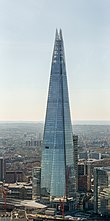Uses

Architecture and windows
Soda-lime sheet glass is typically used as transparent glazing material, typically as windows in external walls of buildings. Float or rolled sheet glass products is cut to size either by scoring and snapping the material, laser cutting, water jets, or diamond bladed saw. The glass may be thermally or chemically tempered (strengthened) for safety and bent or curved during heating. Surface coatings may be added for specific functions such as scratch resistance, blocking specific wavelengths of light (e.g. infrared or ultraviolet), dirt-repellence (e.g. self-cleaning glass), or switchable electrochromic coatings.
Structural glazing systems represent one of the most significant architectural innovations of modern times, where glass buildings now often dominate skylines of many modern cities. These systems use stainless steel fittings countersunk into recesses in the corners of the glass panels allowing strengthened panes to appear unsupported creating a flush exterior. Structural glazing systems have their roots in iron and glass conservatories of the nineteenth century
Tableware
Glass is an essential component of tableware and is typically used for water, beer and wine drinking glasses. Wine glasses are typically stemware, i.e. goblets formed from a bowl, stem, and foot. Crystal or Lead crystal glass may be cut and polished to produce decorative drinking glasses with gleaming facets. Other uses of glass in tableware include decanters, jugs, plates, and bowls.

Wine glasses and other glass tableware

Dimpled glass beer pint jug

Cut lead crystal glass

A glass decanter and stopper
Packaging
The inert and impermeable nature of glass makes it a stable and widely used material for food and drink packaging as glass bottles and jars. Most container glass is soda-lime glass, produced by blowing and pressing techniques. Container glass has a lower magnesium oxide and sodium oxide content than flat glass, and a higher Silica, Calcium oxide, and Aluminum oxide content. Its higher content of water-insoluble oxides imparts slightly higher chemical durability against water, which is advantageous for storing beverages and food. Glass packaging is sustainable, readily recycled, reusable and refillable.
For electronics applications, glass can be used as a substrate in the manufacture of integrated passive devices, thin-film bulk acoustic resonators, and as a hermetic sealing material in device packaging, including very thin solely glass based encapsulation of integrated circuits and other semiconductors in high manufacturing volumes.
Laboratories
Glass is an important material in scientific laboratories for the manufacture of experimental apparatus because it is relatively cheap, readily formed into required shapes for experiment, easy to keep clean, can withstand heat and cold treatment, is generally non-reactive with many reagents, and its transparency allows for the observation of chemical reactions and processes. Laboratory glassware applications include flasks, petri dishes, test tubes, pipettes, graduated cylinders, glass lined metallic containers for chemical processing, fractionation columns, glass pipes, Schlenk lines, gauges, and thermometers. Although most standard laboratory glassware has been mass-produced since the 1920s, scientists still employ skilled glassblowers to manufacture bespoke glass apparatus for their experimental requirements.

A Vigreux column in a laboratory setup

A Schlenk line with four ports

Graduated cylinders

Erlenmeyer flask
Optics
Glass is a ubiquitous material in optics by virtue of its ability to refract, reflect, and transmit light. These and other optical properties can be controlled by varying chemical compositions, thermal treatment, and manufacturing techniques. The many applications of glass in optics includes glasses for eyesight correction, imaging optics (e.g. lenses and mirrors in telescopes, microscopes, and cameras), fibre optics in telecommunications technology, and integrated optics. Microlenses and gradient-index optics (where the refractive index is non-uniform) find application in e.g. reading optical discs, laser printers, photocopiers, and laser diodes.
Art
Glass as art dates to least 1300 B.C. shown as an example of natural glass found in Tutankhamun's pectoral. Enameling, particularly employing vitreous enamel with cloisonné, has existed since 1300 B.C. and arguably peaked in the early 20th century with enamel production from the House of Fabergé in St. Petersburg, Russia. The 19th century saw a revival in ancient glass-making techniques including cameo glass, achieved for the first time since the Roman Empire, initially mostly for pieces in a neo-classical style. The Art Nouveau movement made great use of glass, with René Lalique, Émile Gallé, and Daum of Nancy in the first French wave of the movement, producing coloured vases and similar pieces, often in cameo glass or in luster techniques. Louis Comfort Tiffany in America specialized in stained glass, both secular and religious, in panels and his famous lamps. The early 20th-century saw the large-scale factory production of glass art by firms such as Waterford and Lalique. Small studios may hand-produce glass artworks. Techniques for producing glass art include blowing, kiln-casting, fusing, slumping, pâte de verre, flame-working, hot-sculpting and cold-working. Cold work includes traditional stained glass work and other methods of shaping glass at room temperature. Objects made out of glass include vessels, paperweights, marbles, beads, sculptures and installation art.

Bouquet of Lilies Clock (Fabergé egg) enamel, gold, diamonds, by House of Fabergé

Cameo glass vase with clematis, by art nouveau artist Émile Gallé
Glass vase by art nouveau artist René Lalique
Tiffany glass panel "Girl with Cherry Blossoms"

A glass sculpture by Dale Chihuly, "The Sun" at the "Gardens of Glass" exhibition in Kew Gardens, London

Modern stained glass window

Glass marbles

A flower bouquet glass paperweight
















Comments
Post a Comment